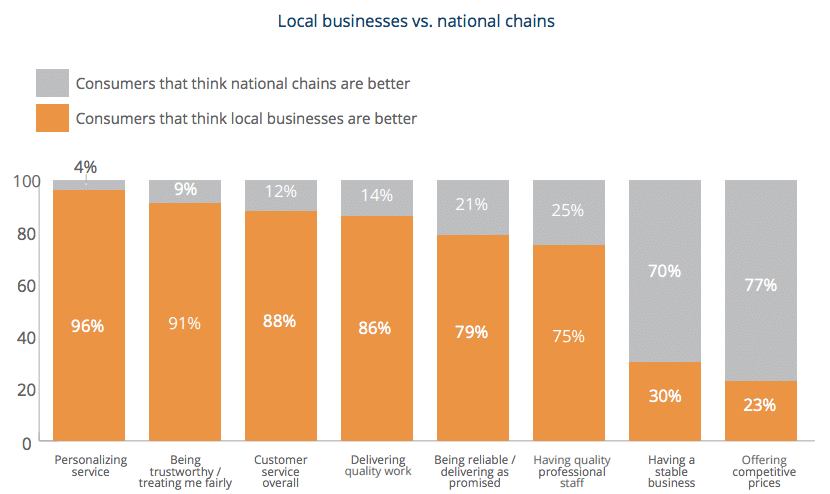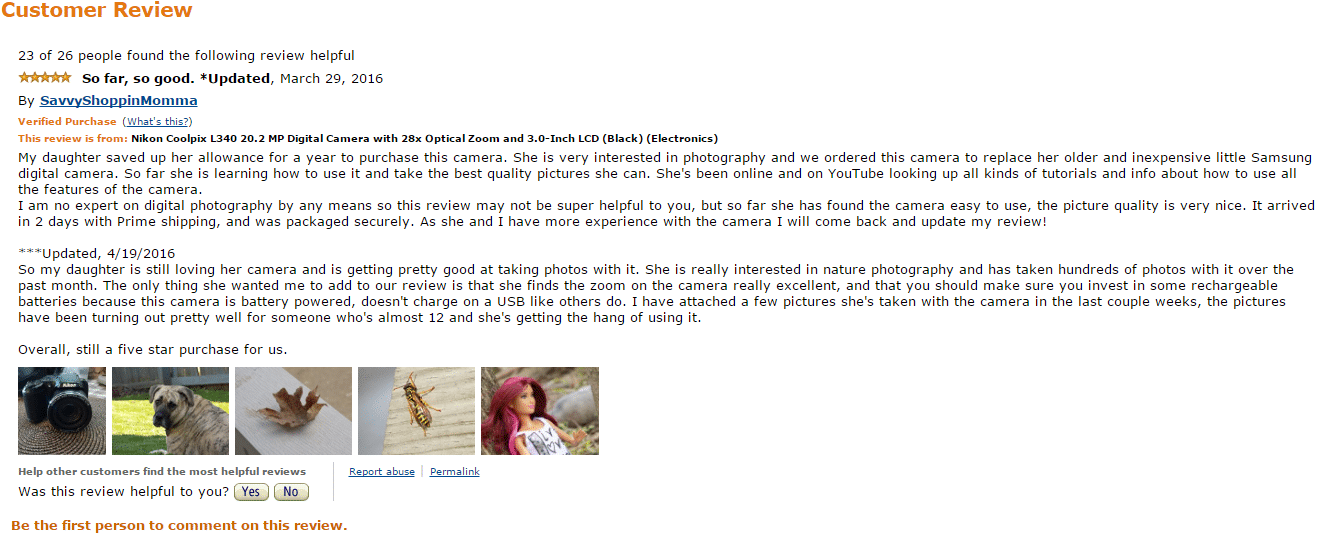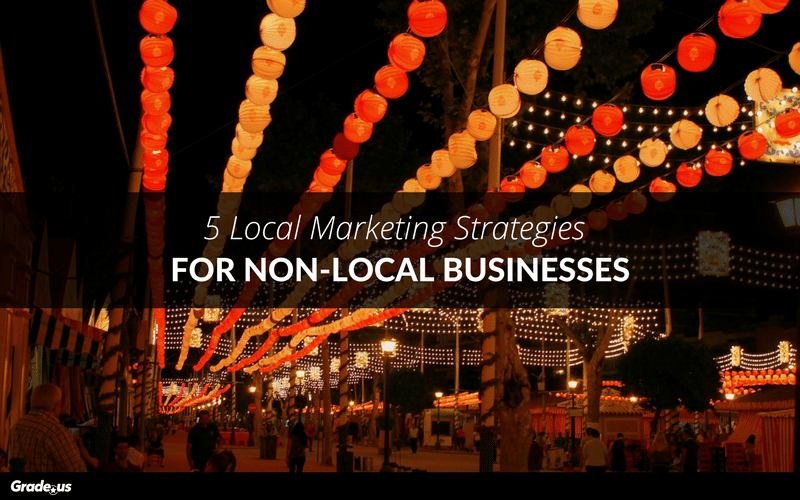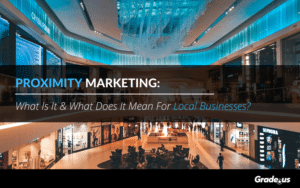Do you remember the shame?
The feeling of rejection inside you when others decide you’re not good enough? It’s something almost all of us go through. We all want to be part of the group.
We all want to fit in.
The ironic part is we’ve all rejected something – people, groups, experiences – you name it. Rejection is an inevitable part of life.
Customers reject businesses
They prefer to shop and buy from local businesses; they really don’t want to work with you.
If you’re an outsider that is.
When you’re a non-local, you’ll have to spend more money to attract the same customers a local business enjoys. What’s worse, you start your relationship at a deficit.
When you’re not local, customers…
- Assume you’re inferior. They believe local businesses do better quality work and offer better quality products.
- Feel you’re stealing from them. Local businesses pump money back into their communities. At some level, the quasi-subconscious perception is this: outsiders won’t support their community.
- Don’t think they matter to you. When it comes to larger and non-local businesses, the perception is: “I’m just a number to you,” which means they…
- Won’t get personalized service. Local businesses are all about relationships. They provide personalized services because they’re a staple or part of the community.
But how do we know customers feel this way?
They tell us.
A recent survey from Yodle made some interesting points about what customers actually want and how they feel about local businesses.
Customers believe local is better
Whether it’s true or not, customers believe local businesses are better than regional or national chains. It isn’t simply a general feeling either. Customers believe local businesses…
- Are more trustworthy
- Deliver better quality work
- Offer better customer service
- Offer more competitive pricing
- Are better at personalizing service
Customers believe local is better.

In fact, customers felt local businesses were lacking in two major but difficult to fix areas.
- Stability. Customers believed regional and national chains were more stable, offering shoppers more security.
- Pricing. Customers felt national chains offered more competitive pricing which makes sense thanks to economies of scale.
These problems aren’t easy to fix, but it can be done with the right approach. Most local businesses won’t fix these problems.
Most simply don’t know how.
Their weakness is your opening
When you use the right strategies, you’re able to circumvent customer bias. When handled well, customers will welcome you past their filters and biases. This strategy is centered around one simple concept.
Relationship.
It doesn’t matter whether your business consists of two locations or two hundred. When it comes to winning local business, elite marketers understand that relationship with influential locals is a key driver.
Relationships, in this context, consist of a few key ingredients.
1. Trust. Reviews are the best way to establish trust quickly. Customers want to verify you’re trustworthy and willing to do right by them. Do you deliver as promised? Are you consistent and reliable? Will you tell the truth even when it hurts?
2. Honor. Works like money. The more you have the more value you’re able to attract. Here’s the tricky part, most of the people in these locales expect you to use your honor in selfless ways. They want you to use your honor to make things in the community better.
3. Selflessness. One hand washes the other. You’re able to give, to serve without expectation. Approach influentials in your locale with the intention of extracting favors and they’ll respond in-kind, shutting your business out.
4. Respect. The locale you’re targeting has its own set of rules, customs, cultures and norms. Learning how to speak the lingo, observe important customs and uphold norms is a crucial part of fitting in.
At first glance these don’t seem like strategies. But savvy customers look for these details. Want to attract more local business? This is the foundation you’ll need to make that happen.
Your foundation needs locals to survive
You won’t have your own “street cred” to start, so you’ll need to rely on locals in your target community.
You’ll need to focus your attention on the right places.
Remember this isn’t about manipulation. It’s about building relationships; these relationships create the opportunities you need to serve locals.
Locals are quick to turn their backs on those who forget.
So.
What are some strategies you can use to compete with the local guys?
Strategy #5: Get reviews from influencers
You’ll want to create an influencer map. These are tangential sources – organizations that are loosely related to yours. If you’re an agency tangential sources could be…
- Chambers of commerce
- Small business organizations
- Rotary clubs
- Professionals (e.g. notable attorneys, accountants and consultants)
If you’re an organic restaurant your tangential sources could be:
- Grocery store co-ops (or stores selling organic products)
- Farmer’s markets
- Farmers local to the state
- Other organic restaurants
Next, find out what each of your tangential sources want.
Is it speakers for their event? Connections or an introduction to someone in your address book? It’s your job to find out. Then, make a pitch to give them what they want in exchange for a review.
Let’s say you’re an organic restaurant in Colorado. You need some local cred so you contact Sun Prairie Beef, an organic cooperative and you make your pitch.
Hi Keith!I’m the co-owner of Harvest Cafe, an organic co-op. I’m looking for an organic co-op I can share with all of my customers. Do you have 5 or 10 minutes to chat?
Best,
Andrew McDermott
Can you see what’s happening?
We’ve opened with an irresistible offer. We’re willing to send all of our customers (something he wants), exclusively to their co-op.
Are they interested?
Of course they are! Most businesses would be chomping at the bit for an opportunity like this. So you create a relationship and you begin to negotiate.
Eventually you make your request for a review like this:
So Keith,Here’s the thing. I want you to know what you’re getting into. Would you guys be willing to give our restaurant an inspection? We’re looking for brutally honest feedback regardless of whether it’s good or bad.
It would mean so much to have your feedback!
Andrew McDermott
Remember the foundation I mentioned earlier? You’re building on that here. Lie to your prospect, use manipulation to hide your motives and you’re out.
Do it right and you have a powerful review from a credible influencer.
Rinse and repeat as necessary.
Every business has tangential sources, so your business can tie influencers to your offer.
Strategy #4: Tie local events to your business
Remember how we created an influencer map just now? We’re going to do that again… using events. The strategy is similar. Figure out what event managers want, then find a way to give it to them.
That could mean…
- Sponsors for an upcoming conference
- Speakers and presenters for an upcoming seminar
- Buying a booth at a food fair
- Offering bonuses to customers attending their event
The sky’s the limit. The important detail to remember with each of these strategies is focusing on the hidden details. There’s the obvious want, the one they’ll tell you about, and the hidden want, the one lurking below the surface.
Find both and your odds of success skyrocket.
Already discovered their obvious and hidden wants? Great! You’re ready to make your pitch.
Hi Jan!I heard through the grapevine that you’re looking to get in touch with a celebrity chef for the upcoming Pawnee food fair.
If I could get Missy Robbins, a Top Chef Masters finalist to host a free panel, would you be interested?
Andrew McDermott
Here’s the secret sauce to this strategy. You nail down the solution first, before making your pitch. Once you figure out what the Pawnee Food Fair event staff needs (a celebrity chef), you quietly reach out to several chefs that meet their criteria.
You get the solution on board first, then you approach event managers. This strategy fails when it’s done in reverse.
Strategy #3: Infiltrate key local groups
Join target groups filled with customers and or tangential sources. Then, serve, same as before.
If your target audience is entrepreneurs you…
- Infiltrate local entrepreneur and startup groups (e.g. chamber of commerce, BNI, rotary clubs, etc.)
- Run workshops for libraries, meet-ups, and specialty groups
- Join specialty groups (both local and national) like Young entrepreneurs council, Startup grind, vistage, and USASBE
- Reach out to tangential groups (e.g. attorneys, accountants, it pros, local hosting companies, etc.) and show them how to build and serve their audience
The key to infiltration? Serving. If you want to create a large local audience of your own, serve without expectation.
Here’s the catch.
Serve incompletely – give the milk away free, rent the cow. Give ideas away, sell the system.
There are lots of ways to serve these groups. You can…
- Teach what you know and share your advice
- Become a master connector, bringing people together
- Act as the group maven, locating hard to find resources
- Influencers, it’s a good idea to present content that:
a. serves their audience directly,
b. shows them how to serve their audience or
c. teaches them how to extract more value from the relationship.
- Customers, focus first on fascinating and surprising them to attract their attention. Then, once they’re focused on you, educate, showing them how to solve their problems, fears, and frustrations.
- Both influencers and customers in the same audience, use a mix of both strategies above, doing your best to segment your audience whenever and wherever you can. Offering value + surprise means customers and influencers are (much) less likely to turn to a competitor for help and support.
Stick to the foundational elements we’ve discussed earlier. Be trustworthy, honorable, selfless, and respectful to maintain your place in the group.
Strategy #2: Be a force for good in “your” community
Are there people in the community who need help? Who helps them? Find the tangential sources that serve those who need help.
Look closely and you’ll find people who need help. Entrepreneurs get help from…
- Score, the SBA, and small business incubators
- Service providers (e.g. mailbox, phone system providers)
- Financiers offering business credit, loans and lines of credit
Running a restaurant? You can serve…
- Homeless shelters
- After school and childcare programs
- Clubs (e.g. Boys and Girls Clubs of America)
- Clubs (e.g. Boys and Girls Clubs of America)
Running an IT consultancy? You can…
- Provide non-profits with free tech support
- Offer support to a select number of businesses
- Provide free recovery tools for people and businesses infected with rootkits, ransomware and trojans
- Connect phishing victims to companies that undo damage caused by hacking
When it’s done well, you attract a considerable amount of attention from locals.
What makes this so different?
Why should a non-local business spend the money, take the time, make the effort needed to attract local customers? Wouldn’t it be easier to simply offer lower prices, talk up the fact that you’re a stable business – anything along those lines?
You could.
And the worst part? It would work. That’s a problem because short term strategies produce short term results. Increase your prices, create steep discounts and customers come running.
When that goes away so do your customers.
Strategy #1: Partner with established local players
Partnering with established local players won’t work.
Not because it can’t work but because the proper groundwork hasn’t been laid. Inexperienced players immediately ask for a favor.
And just as immediately, they’re denied.
Or rather, ignored.
These local players are influencers. Day after day they’re constantly bombarded by people looking for a favor. People looking for access to their audience, network or resources.
And most of the time these favor seekers aren’t bringing anything of value to the table.
That’s a problem.
Getting influencer help makes everything easier. Getting local customers to open up is much easier when an established, trustworthy player is willing to vouch for you.
How on earth are you supposed to get them to vouch for you?
By following strategies two through four. Do a great job with these details and established local players start to notice. Your reputation, your good works in the community precedes you.
But, what if it doesn’t?
You can still bring it up when you make your pitch. That’s significant because it gives local players the things they want.
Okay, what do they want?
1. Protection. These local players want to protect their audience or network from time wasters and selfish people who are only looking out for themselves.
2. Commitment. Locals want to see that you’re in it for the long haul, that you’re truly committed to serving the community on your own and not because of them.
3. Character. Remember earlier when I talked about building a strong foundation? Established locals want to see that you’re trustworthy, loyal, honorable, and respectful even if they’re not.
4. Guarantees. They want assurances from you. They want to know that you’ll deliver the value you’ve promised. When things go wrong, as they inevitably will, they want to see that you have a plan. That you’ve thought this through and you know how to make things happen.
The strategies we’ve just talked about accomplish that.
If you’ve worked with one of the strategies we mentioned earlier you should have a pretty good idea about what established locals are looking for.
You should also have a solution in mind.
That means you’re ready to make your pitch. You create an irresistible offer for established local players. You use the success you’ve achieved from the previous strategies as social proof.
Let’s say you’re targeting the group leader of a local entrepreneur club. You want the leader to promote your marketing services to their audience. You could tailor your pitch to an influencer’s audience, like this:
Hey Jan,Wanted to run something past you. Rick mentioned the Entrepreneurs Incubator club was growing. I was told 43% of the businesses in your club went out of business last year alone, and it seems to be getting worse. It seems like this had a negative impact on membership dues.
I can double your membership dues and reduce lost members by half. I’m willing to do that for free.
How would you like me to proceed?
Andrew McDermott
See what I did there?
I used several key ingredients in my pitch. If we’ve done our homework (and we have), these ingredients dramatically increase our success ratio.
1. “wanted to run something past you” implicitly acknowledges Jan’s status and power.
2. “Rick mentioned” I’ve done my homework and come prepared. This conveys competence and status.
3. “43%… went out of business” introduces the problem and agitates it, raising Jan’s stress and anxiety levels. Jan is now primed for a solution.
4. “a negative impact on membership dues… getting worse” expands the problem, showing the consequence of the problem if it remains unsolved.
5. “double your membership dues and reduce lost members by half” Jan is primed with an irresistible offer that creates mystique. The solution is hers. All she has to do is talk to me.
If we’ve flushed out Jan’s problem, the solution will be tough for her to ignore.
Every day, elite non-local businesses quietly put these strategies to work, winning customers, sales and reviews for their businesses.
These strategies hide a wonderful secret
They produce amazing reviews. Make influencers and their customers happy and you create an environment where people are eager to share their reviews.
When you ask for feedback it’s as if the reviews write themselves.
But it’s the quality behind these reviews that makes such a difference. The quality behind these reviews are incredibly different.
Still not sure? Compare this review…

with this one.

See what I mean? These are the kind of reviews that attract customers indefinitely. These reviews become beacons, attracting new customers as people continue to talk about the amazing things you’ve done to serve others.
Serving sounds like a lot of work
At first glance, these strategies seem like too much work. But it’s really all about you. What do you want?
Some people are okay with short term goals.
Slashing prices, a massive ad campaign, strategies like these make sense if you’re consistently focused on trying something new.
- Short term work produces short term results
- Long term work produces evergreen results
The adage is true in most cases. It’s true here.
Serve insiders and eventually, you become one. Be indispensable and focused on giving and serving; you’ll attract the influence, attention and customers you need.
Customers reject outsiders
They prefer to shop and buy from local businesses; when you’re an outsider they really don’t want to work with you.
Most throw money at the problem, but the consequences never really go away. Stop slashing prices, fail to give customers deep discounts and you’ll find their loyalty is only skin deep.
You don’t have to start your relationship at a deficit.
As a non-local, you can attract all the locals you can handle – if you have the right strategies in place. Rejection is inevitable but it doesn’t have to be permanent.
Serve locals and they’ll serve you. Give with the right foundation and you’ll find selling to locals comes naturally, all profit and no shame.
About the Author
Andrew McDermott
Andrew McDermott is the co-founder of HooktoWin. He shows entrepreneurs how to attract and win new customers.











